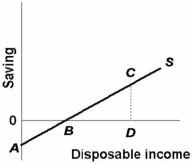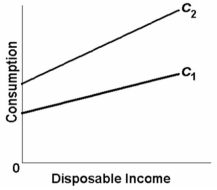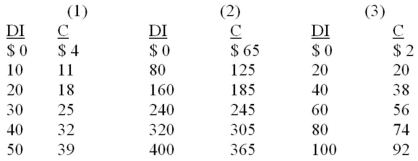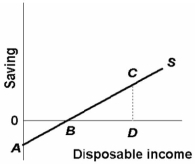A) investment will rise until it is equal to saving.
B) we will be uncertain as to the resulting change in investment.
C) we can be certain that investment will rise.
D) we can be certain that investment will fall.
Correct Answer

verified
Correct Answer
verified
Multiple Choice
The investment-demand curve will shift to the left as a result of:
A) an increase in the excess productive capacity available in industry.
B) a decrease in business taxes.
C) increased business optimism with respect to future economic conditions.
D) a decrease in labor costs.
Correct Answer

verified
Correct Answer
verified
Multiple Choice
 -The above table reflects a(n) :
-The above table reflects a(n) :
A) interest rate schedule.
B) demand-for-money schedule.
C) investment-demand schedule.
D) profit schedule.
Correct Answer

verified
Correct Answer
verified
Multiple Choice
If the marginal propensity to consume is 0.9 in a private closed economy, a $20 billion decline in investment spending will decrease:
A) GDP by $20 billion.
B) GDP by $100 billion.
C) saving by $20 billion.
D) consumption by $200 billion.
Correct Answer

verified
Correct Answer
verified
Multiple Choice
The saving schedule shown in the diagram below would shift downward if, all else equal: 
A) the average propensity to save increased at each income level.
B) the marginal propensity to save rose at each income level.
C) consumer wealth rose rapidly because of a significant increase in stock market prices.
D) the real interest rate increased.
Correct Answer

verified
Correct Answer
verified
Multiple Choice
 -The above figure shows the saving schedules for economies 1, 2, 3, and 4. Which economy has the highest marginal propensity to consume?
-The above figure shows the saving schedules for economies 1, 2, 3, and 4. Which economy has the highest marginal propensity to consume?
A) 1
B) 2
C) 3
D) 4
Correct Answer

verified
Correct Answer
verified
True/False
The average propensity to consume can be defined as income divided by consumption.
Correct Answer

verified
Correct Answer
verified
Multiple Choice
Suppose that a new machine tool having a useful life of only one year costs $80,000. Suppose, also, that the net additional revenue resulting from buying this tool is expected to be $96,000. The expected rate of return on this tool is:
A) 80 percent.
B) 8 percent.
C) 2 percent.
D) 20 percent.
Correct Answer

verified
Correct Answer
verified
Multiple Choice
Which of the following will not tend to shift the consumption schedule upward?
A) a currently small stock of durable goods in the possession of consumers
B) the expectation of a future decline in the consumer price index
C) a currently low level of household debt.
D) the expectation of future shortages of essential consumer goods.
Correct Answer

verified
Correct Answer
verified
Multiple Choice
Suppose an economy's consumption schedule shifts from C1 to C 2 as shown in the diagram below. We can say that its: 
A) MPC has increased but its APC at each income level is unchanged.
B) APC at each income level is increased but its MPC is unchanged.
C) MPC and APC at each income level have both increased.
D) MPC and APC at each income level have both decreased.
Correct Answer

verified
Correct Answer
verified
Multiple Choice
The APC can be defined as the fraction of a:
A) change in income which is not spent.
B) change in income which is spent.
C) specific level of total income which is not consumed.
D) specific level of total income which is consumed.
Correct Answer

verified
Correct Answer
verified
True/False
The slope of the consumption schedule is measured by the MPC.
Correct Answer

verified
Correct Answer
verified
Multiple Choice
The consumption schedule is drawn on the assumption that as disposable income increases consumption will:
A) be unaffected.
B) increase absolutely, but remain constant as a percentage of income.
C) increase absolutely, but decline as a percentage of income.
D) increase absolutely and as a percentage of income.
Correct Answer

verified
Correct Answer
verified
True/False
A business firm will purchase additional capital goods if the real rate of interest it must pay is less than the expected rate of return from the investment.
Correct Answer

verified
Correct Answer
verified
Multiple Choice
Following is consumption schedules for three private closed economies. DI signifies disposable income and C represents consumption expenditures. All figures are in billions of dollars.
 -Refer to the above data. The marginal propensity to save:
-Refer to the above data. The marginal propensity to save:
A) is highest in economy (1) .
B) is highest in economy (2) .
C) is highest in economy (3) .
D) cannot be determined from the data given.
Correct Answer

verified
Correct Answer
verified
Multiple Choice
If the marginal propensity to save is 0.2 in a private closed economy, a $20 billion rise in investment spending will increase:
A) GDP by $120 billion.
B) GDP by $20 billion.
C) saving by $25 billion.
D) consumption by $80 billion.
Correct Answer

verified
Correct Answer
verified
Multiple Choice
The multiplier:
A) varies directly with the slope of the investment-demand schedule.
B) is unrelated to the slope of the saving schedule.
C) will be greater, the smaller the slope of the saving schedule.
D) will be greater, the steeper the slope of the saving schedule.
Correct Answer

verified
Correct Answer
verified
Multiple Choice
Suppose a family's consumption exceeds its disposable income. This means that its:
A) MPC is greater than 1.
B) MPS is negative.
C) APC is greater than 1.
D) APS is positive.
Correct Answer

verified
Correct Answer
verified
Multiple Choice
If the nominal interest rate is 18 percent and the real interest rate is 6 percent, the inflation rate is:
A) 18 percent.
B) 24 percent.
C) 12 percent.
D) 6 percent.
Correct Answer

verified
Correct Answer
verified
Multiple Choice
 -Refer to the above diagram. The marginal propensity to save is equal to:
-Refer to the above diagram. The marginal propensity to save is equal to:
A) CD/0D.
B) 0B/0A.
C) 0D/0D.
D) CD/BD.
Correct Answer

verified
Correct Answer
verified
Showing 21 - 40 of 188
Related Exams